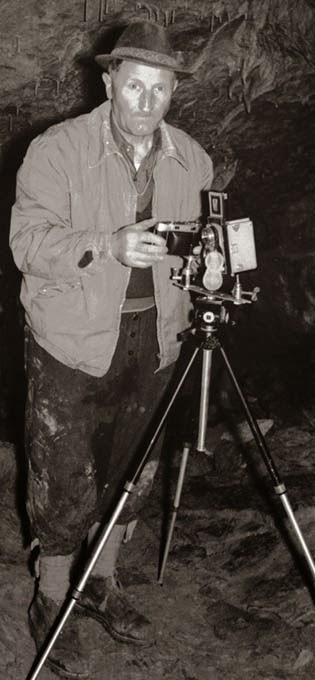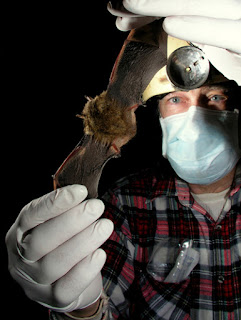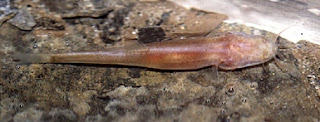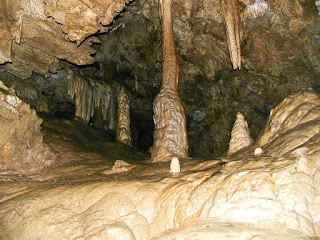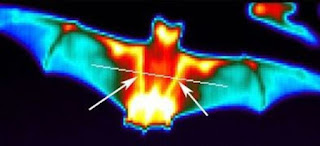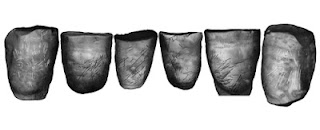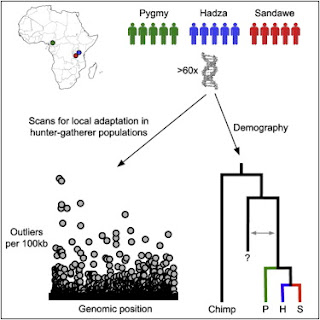The France HABE Prize is awarded by the Department of Karst and the Cave Protection of the International Union of Speleology (UIS).
Its purpose is to promote the protection of karst and caves for generations to come. Their natural legacy are proven sources of increasingly rich information about the history of our planet and humanity, enabling people to act more thoughtfully, efficiently, and sustainably for the future of our environment.
Nominations must reach by, May 20 2014.
Click here for more information
Showing posts with label science. Show all posts
Showing posts with label science. Show all posts
Friday, April 11, 2014
Last Call - France HABE Prize
Email ThisBlogThis!Share to TwitterShare to FacebookShare to Pinterest
Thursday, June 6, 2013
Slicing Open Stalagmites to Reveal Climate Secrets
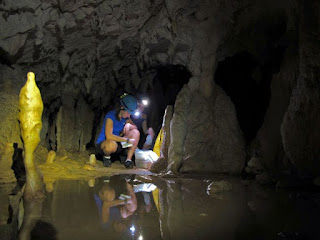 |
| Stacy Carolin collects samples in a Borneo cave last fall. Photo by Syria Lejau |
A few years later, Carolin, a Ph.D. student at Georgia Tech, is breaking ground in the field of paleoclimatology, the study of ancient climates, using an unconventional but increasingly prevalent tool: speleothems, a catch-all term for cave formations that includes stalagmites (remember the mnemonic: those that "mite" reach the ceiling from the floor) and stalactites (those that hold "tite" to the ceiling).
Email ThisBlogThis!Share to TwitterShare to FacebookShare to Pinterest
Tuesday, May 28, 2013
Smokies, Mammoth Cave part of MTSU science study
Ten college students from across the country are taking part in a Middle Tennessee State University environmental research project.
The event runs from through July 26 and is funded by the National Science Foundation.
The school says the students will search for ancient inactive seismic faults, investigate water and air quality and explore the ecology of rare cedar glade habitats. The intensified research project involves the disciplines of Earth science, chemistry and biology.
Field trips will take them to Mammoth Cave and the Great Smoky Mountains National Park.
The NSF grant of $368,000 also will enable MTSU to host similar studies in 2014 and 2015.
Source: Kentucky.com
The event runs from through July 26 and is funded by the National Science Foundation.
The school says the students will search for ancient inactive seismic faults, investigate water and air quality and explore the ecology of rare cedar glade habitats. The intensified research project involves the disciplines of Earth science, chemistry and biology.
Field trips will take them to Mammoth Cave and the Great Smoky Mountains National Park.
The NSF grant of $368,000 also will enable MTSU to host similar studies in 2014 and 2015.
Source: Kentucky.com
Email ThisBlogThis!Share to TwitterShare to FacebookShare to Pinterest
Thursday, May 23, 2013
New cave-dwelling whip scorpion species found
 |
| Rowlandius ubajara (above) is one of two new cave-dwelling whip scorpion species discovered in northeastern Brazil. |
Whip scorpions are not true scorpions, but rather part of a group of arachnids that don't have stings and are not poisonous. They possess a whip-like tail, but look more like ants.
Previously, scientists thought whip scorpions came predominantly from the Caribbean. The new species, Rowlandius ubajara and Rowlandius potiguara, are some of the first from South America.
Email ThisBlogThis!Share to TwitterShare to FacebookShare to Pinterest
Monday, April 15, 2013
21 st International Karstological School: Classical Karst: Hypogene Speleogenesis (Between theory and reality...)
Since 1993, International Karstological Schools have been organised, covering many aspects of karst research. The basic idea of the School has been to present the state of the art in selected topics and promote discussion between participants via set of lectures, poster sessions and related field trips to the area of Slovene Classical karst.
In the last decade, hypogene speleologenetic processes have attracted attention of speleological community. Many previously epigenic caves have been reinterpreted as hypogene. Some basic publications on the topic have triggered doubts and debates because similar cave patterns and wall rock features considered as hypogene can be formed also under other conditions. Therefore, the aim of the 21'st IKS is to present basic hydrogeological and chemical principles and processes of hypogene speleogenesis as well as geological conditions leading to it. Special attention will be paid to the geometry of cave passages and wall rock features which are often interpreted as hypogene, but could have as well formed otherwise, such as in meteoric flood-water conditions or by dissolution in contact with sediment.
In the last decade, hypogene speleologenetic processes have attracted attention of speleological community. Many previously epigenic caves have been reinterpreted as hypogene. Some basic publications on the topic have triggered doubts and debates because similar cave patterns and wall rock features considered as hypogene can be formed also under other conditions. Therefore, the aim of the 21'st IKS is to present basic hydrogeological and chemical principles and processes of hypogene speleogenesis as well as geological conditions leading to it. Special attention will be paid to the geometry of cave passages and wall rock features which are often interpreted as hypogene, but could have as well formed otherwise, such as in meteoric flood-water conditions or by dissolution in contact with sediment.
Info: http://iks.zrc-sazu.si/en/
Email ThisBlogThis!Share to TwitterShare to FacebookShare to Pinterest
Friday, December 28, 2012
Cave Dwelling Nettle Discovered in China
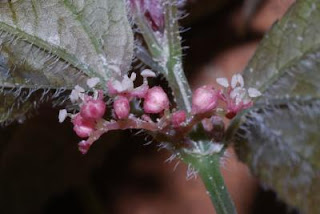 |
| Flowers of a new species from the nettle family known only from caves, Pilea cavernicola, where it grows in very low light conditions. |
South West China, Myanmar and Northern Vietnam contain one of the oldest exposed outcrops of limestone in the world. Within this area are thousands of caves and gorges. It is only recently that botanists have sought to explore the caves for plants. This exploration is yielding many new species new to science, that are known only from these habitats.
The current study was published in the open access journal PhytoKeys.
Kew botanist and nettle expert Alex Monro says, "When my Chinese colleague Wei Yi-Gang from the Guangxi Institute of Botany first mentioned cave-dwelling plants to me, I thought that he was mis-translating a Chinese word into English. When we stepped into our first cave, Yangzi cave, I was spell-bound. It had an eerie moonscape look to it and all I could see were clumps of plants in the nettle family growing in very dark condition."
The plants do not grow in complete darkness but do grow in extremely low light levels, deep within the entrance caverns of the caves (sometimes, in as little as 0.04% full sunlight). The British and Chinese authors have been collecting plants from the Nettle family in this limestone landscape for several years and have just published a paper describing three new species, one from a cave and another two from deep gorges.
The cave-dwelling nettle species in question, was found growing in two caves in the Guangxi province of China. Of the species discovered in gorges, one is known from an unusual and striking rock mineral formation called petaloid travertine. Petaloid travertine is a form of limestone deposited by mineral springs that over time forms large petals of rock, in this case clinging to the vertical walls of a gorge.
These plants are members of a genus of Nettles known as Pilea, that is believed to have over 700 species Worldwide, up to one third of which may remain undescribed.
Journal Reference:
Alex Monro, Y.G. Wei, C.J. Chen. Three new species of Pilea (Urticaceae) from limestone karst in China. PhytoKeys, 2012; 19 (0): 51 DOI:10.3897/phytokeys.19.3968
Kew botanist and nettle expert Alex Monro says, "When my Chinese colleague Wei Yi-Gang from the Guangxi Institute of Botany first mentioned cave-dwelling plants to me, I thought that he was mis-translating a Chinese word into English. When we stepped into our first cave, Yangzi cave, I was spell-bound. It had an eerie moonscape look to it and all I could see were clumps of plants in the nettle family growing in very dark condition."
The plants do not grow in complete darkness but do grow in extremely low light levels, deep within the entrance caverns of the caves (sometimes, in as little as 0.04% full sunlight). The British and Chinese authors have been collecting plants from the Nettle family in this limestone landscape for several years and have just published a paper describing three new species, one from a cave and another two from deep gorges.
The cave-dwelling nettle species in question, was found growing in two caves in the Guangxi province of China. Of the species discovered in gorges, one is known from an unusual and striking rock mineral formation called petaloid travertine. Petaloid travertine is a form of limestone deposited by mineral springs that over time forms large petals of rock, in this case clinging to the vertical walls of a gorge.
These plants are members of a genus of Nettles known as Pilea, that is believed to have over 700 species Worldwide, up to one third of which may remain undescribed.
Journal Reference:
Alex Monro, Y.G. Wei, C.J. Chen. Three new species of Pilea (Urticaceae) from limestone karst in China. PhytoKeys, 2012; 19 (0): 51 DOI:10.3897/phytokeys.19.3968
Email ThisBlogThis!Share to TwitterShare to FacebookShare to Pinterest
Thursday, December 20, 2012
Researchers find link between bats and treatment of human diseases
 |
| Dr Chris Cowled hard at work |
Their paper, published today in the journal Science, provides an insight into the evolution of the bat’s flight, resistance to viruses, and relatively long life.
The Bat Pack, in collaboration with the Beijing Genome Institute, led a team that sequenced the genomes of two bat species - the Black Flying Fox, an Australian mega bat, and the David’s Myotis, a Chinese micro bat.
Once the genomes were sequenced, they compared them to the genomes of other mammals, including humans, to find where the similarities and differences lay.
Chris Cowled, post-doctoral fellow at AAHL says the research may eventually lead to strategies to treat, or even prevent disease in humans.
Email ThisBlogThis!Share to TwitterShare to FacebookShare to Pinterest
Tuesday, December 18, 2012
New paper on karstic flow conduits
A new paper is published in the current issue of "Speleogenesis and Evolution of karst aquifers":
Boudinet, P. 2012. A statistical model of karstic flow conduits.
Speleogenesis & Evolution of Karst Aquifers, 12: 9-16
A statistical model of karstic flow conduits, based on statistical physics of random walks, is developed. It allows us to compute the mean depth of flow conduits versus the distance from the inlet and versus the dip. It provides results that are in good qualitative agreement with previous results of other authors: the mean depth increases, slowly, with the distance, and it increases, not in a regular fashion, with the dip. The variability of the depth of the conduits, possibly leading to some conduits far from the water table, and the fact that well developed conduits are scarce or not, is linked to the probability of exploitation of the different fractures, the potentially permeable bedding planes, faults and joints in the karstifiable rock. On the basis of this result, we propose that interesting cavities - from the point of view of caving and cave diving - are found only in a small range of those exploitation probabilities. Finally, we emphasize the non-euclidean properties of flow conduits; especially, that many shortest pathways may exist and that a straight line is not usually the shortest pathway that actually develops between inlet and outlet.
To download the full paper, please, follow this link:
http://www.speleogenesis.info/journal/publication.php?id=11251
Boudinet, P. 2012. A statistical model of karstic flow conduits.
Speleogenesis & Evolution of Karst Aquifers, 12: 9-16
A statistical model of karstic flow conduits, based on statistical physics of random walks, is developed. It allows us to compute the mean depth of flow conduits versus the distance from the inlet and versus the dip. It provides results that are in good qualitative agreement with previous results of other authors: the mean depth increases, slowly, with the distance, and it increases, not in a regular fashion, with the dip. The variability of the depth of the conduits, possibly leading to some conduits far from the water table, and the fact that well developed conduits are scarce or not, is linked to the probability of exploitation of the different fractures, the potentially permeable bedding planes, faults and joints in the karstifiable rock. On the basis of this result, we propose that interesting cavities - from the point of view of caving and cave diving - are found only in a small range of those exploitation probabilities. Finally, we emphasize the non-euclidean properties of flow conduits; especially, that many shortest pathways may exist and that a straight line is not usually the shortest pathway that actually develops between inlet and outlet.
To download the full paper, please, follow this link:
http://www.speleogenesis.info/journal/publication.php?id=11251
Email ThisBlogThis!Share to TwitterShare to FacebookShare to Pinterest
Friday, December 14, 2012
Bad News for Bats: Deadly Fungus Persists in Caves
A study just published in Applied and Environmental Microbiology shows that the fungus can survive in soil for months, even years, after the bats have departed.
This is not good news for the bat population, says lead author Jeff Lorch, a research associate in the Department of Forest and Wildlife Ecology at the University of Wisconsin-Madison. "We have found that caves and mines, which remain cool year-round, can serve as reservoirs for the fungus, so bats entering previously infected sites may contract white-nose syndrome from that environment. This represents an important and adverse transmission route."
"This certainly presents additional challenges," adds David Blehert, a microbiologist at the U.S. Geological Survey National Wildlife Health Center in Madison, who also led the study. "It's important that we have completed this foundational work that further implicates the environment in the ecology of this infectious disease. We can now collectively move forward to address this problem."
This is not good news for the bat population, says lead author Jeff Lorch, a research associate in the Department of Forest and Wildlife Ecology at the University of Wisconsin-Madison. "We have found that caves and mines, which remain cool year-round, can serve as reservoirs for the fungus, so bats entering previously infected sites may contract white-nose syndrome from that environment. This represents an important and adverse transmission route."
"This certainly presents additional challenges," adds David Blehert, a microbiologist at the U.S. Geological Survey National Wildlife Health Center in Madison, who also led the study. "It's important that we have completed this foundational work that further implicates the environment in the ecology of this infectious disease. We can now collectively move forward to address this problem."
Email ThisBlogThis!Share to TwitterShare to FacebookShare to Pinterest
Thursday, December 13, 2012
Blind cave fish inspires sensing system for autonomous underwater vehicles
Ever wonder how fish can find their way around so easily in murky water? Well, most of them use something called their lateral line - a row of hair cells down either side of their body that detect changes in water pressure caused by movement, or by water flowing around objects. Now, scientists from Singapore’s Nanyang Technological University and MIT have copied the lateral lines of the blind cave fish, in a man-made system designed to allow autonomous underwater vehicles (AUVs) to navigate more accurately and efficiently.
Ordinarily, AUVs use cameras, sonar, or an underwater acoustic positioning system. Cameras aren’t much use in murky water, however - and a lot of the world’s water bodies are murky. Sonar and acoustics are better in such situations, but the hardware can be expensive, and taxing on the AUV’s batteries.
Ordinarily, AUVs use cameras, sonar, or an underwater acoustic positioning system. Cameras aren’t much use in murky water, however - and a lot of the world’s water bodies are murky. Sonar and acoustics are better in such situations, but the hardware can be expensive, and taxing on the AUV’s batteries.
Email ThisBlogThis!Share to TwitterShare to FacebookShare to Pinterest
Sunday, December 9, 2012
Research on stricken bats may help AIDS fight
The remote possibility that an AIDS treatment can arise from the study of white-nose is about the only positive development since the bat disease was first discovered in a cave near Albany, N.Y., in 2008.
Between 5 million and 7 million bats of various species have died from the disease since that year. In Pennsylvania alone, 95 percent of little brown bats have died.
Bats have an ugly reputation as villains in books and movies, but in reality are as important as birds and bees. They pollinate plants, and a single reproductive female consumes her weight in bugs each night. A colony of 150 brown bats can eat enough adult cucumber beetles to prevent the laying of eggs that results in 33 million rootworm larvae in summer, according to a study cited by Bat Conservation International.
Between 5 million and 7 million bats of various species have died from the disease since that year. In Pennsylvania alone, 95 percent of little brown bats have died.
Bats have an ugly reputation as villains in books and movies, but in reality are as important as birds and bees. They pollinate plants, and a single reproductive female consumes her weight in bugs each night. A colony of 150 brown bats can eat enough adult cucumber beetles to prevent the laying of eggs that results in 33 million rootworm larvae in summer, according to a study cited by Bat Conservation International.
Email ThisBlogThis!Share to TwitterShare to FacebookShare to Pinterest
Friday, November 30, 2012
New Eyeless, Scaleless Cave Fish Discovered in Vietnam
A cave-dwelling fish with no eyes and no scales has been discovered on a tiny island in Vietnam's scenic Ha Long Bay, according to conservation group Fauna & Flora International.
The newly described fish, a type of loach, has been named Draconectes narinosus, which derives from the Greek words for dragon "drakon" and swimmer "nectes," as well as the Latin word "narinosus," which means "who has large nostrils."
Its lack of eyes and scales are actually common adaptations for animals that have evolved in the darkness of deep limestone caverns. Like other cave fish, D. narinosus is limited to a life in freshwater, which means it is likely confined to a system of subterranean caves on Van Gio Island, unable to swim out into the surrounding sea.
The newly described fish, a type of loach, has been named Draconectes narinosus, which derives from the Greek words for dragon "drakon" and swimmer "nectes," as well as the Latin word "narinosus," which means "who has large nostrils."
Its lack of eyes and scales are actually common adaptations for animals that have evolved in the darkness of deep limestone caverns. Like other cave fish, D. narinosus is limited to a life in freshwater, which means it is likely confined to a system of subterranean caves on Van Gio Island, unable to swim out into the surrounding sea.
Email ThisBlogThis!Share to TwitterShare to FacebookShare to Pinterest
Wednesday, November 28, 2012
Cave Structure Tells Tale of 13,000 Winters
Scientists have found a stalagmite in an Oregon cave that tells the story of thousands of winters in the Pacific Northwest.
"Most other ways of estimating past climate, like tree-ring data, only tell us about summers, when plants are growing," Oxford University researcher Vasile Ersek said in a statement. But understanding ancient winters is also important for regions like western North America, where chilly conditions are critical for determining water resources.
For their study, Ersek and his colleagues examined a cave formation called a stalagmite that started forming 13,000 years ago in a cavern in what is now Oregon Caves National Monument. During the region's damp winters, water from the ground seeped through the cave's ceiling and trickled onto the floor, with the drips slowly forming the stalagmite over time.
"Most other ways of estimating past climate, like tree-ring data, only tell us about summers, when plants are growing," Oxford University researcher Vasile Ersek said in a statement. But understanding ancient winters is also important for regions like western North America, where chilly conditions are critical for determining water resources.
For their study, Ersek and his colleagues examined a cave formation called a stalagmite that started forming 13,000 years ago in a cavern in what is now Oregon Caves National Monument. During the region's damp winters, water from the ground seeped through the cave's ceiling and trickled onto the floor, with the drips slowly forming the stalagmite over time.
Email ThisBlogThis!Share to TwitterShare to FacebookShare to Pinterest
Skeletons in cave reveal Mediterranean secrets
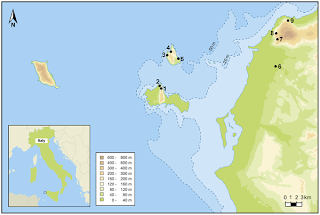 |
| Location of Upper Palaeolithic and Mesolithic sites on the Ègadi Islands and in NW Sicily. |
Skeletal remains in an island cave in Favignana, Italy, reveal that modern humans first settled in Sicily around the time of the last ice age and despite living on Mediterranean islands, ate little seafood. The research is published November 28 in the open access journal PLOS ONE by Marcello Mannino and colleagues from the Max Planck Institute for Evolutionary Anthropology, Germany.
Genetic analysis of the bones discovered in caves on the Egadi islands provides some of the first mitochondrial DNA data available for early humans from the Mediterranean region, a crucial piece of evidence in ancestry analysis. This analysis reveals the time when modern humans reached these islands. Mannino says, "The definitive peopling of Sicily by modern humans only occurred at the peak of the last ice age, around 19,000 -26,500 years ago, when sea levels were low enough to expose a land bridge between the island and the Italian peninsula".
The authors also analyzed the chemical composition of the human remains and found that these early settlers retained their hunter-gatherer lifestyles, relying on terrestrial animals rather than marine sources for meat. According to the study, despite living on islands during a time when sea level rise was rapid enough to change within a single human lifetime, these early settlers appear to have made little use of the marine resources available to them. The authors conclude, "These findings have crucial implications for studies of the role of seafood in the diet of Mediterranean hunter-gatherers."
Scientific article:
Mannino MA, Catalano G, Talamo S, Mannino G, Di Salvo R, et al. (2012) Origin and Diet of the Prehistoric Hunter-Gatherers on the Mediterranean Island of Favignana (E`gadi Islands, Sicily). PLoS ONE 7(11): e49802. doi:10.1371/journal.pone.0049802
Email ThisBlogThis!Share to TwitterShare to FacebookShare to Pinterest
Friday, November 9, 2012
Thermal scans of bat faces warn of infected individuals before they show symptoms.
Bats are a major reservoir for the rabies virus, according to the Centers for Disease Control and Prevention (CDC) in Atlanta.
Rabies, typically transmitted in saliva, targets the brain and is almost always fatal in animals and people if left untreated. No current tests detect rabies in live animals—only brain tissue analysis is accurate.
Searching for a way to detect the virus in bats before the animals died, rabies specialist James Ellison and his colleagues at the CDC turned to a captive colony of big brown bats (Eptesicus fuscus). Previous studies had found temperature increases in the noses of rabid raccoons, so the team expected to see similar results with bats.
Rabies, typically transmitted in saliva, targets the brain and is almost always fatal in animals and people if left untreated. No current tests detect rabies in live animals—only brain tissue analysis is accurate.
Searching for a way to detect the virus in bats before the animals died, rabies specialist James Ellison and his colleagues at the CDC turned to a captive colony of big brown bats (Eptesicus fuscus). Previous studies had found temperature increases in the noses of rabid raccoons, so the team expected to see similar results with bats.
Email ThisBlogThis!Share to TwitterShare to FacebookShare to Pinterest
Monday, October 1, 2012
Three New Arthropod Species Have Been Found in the Maestrazgo Caves in Teruel
 |
| Pygmarrhopalites maestrazgoensis |
The Maestrazgo caves in Teruel are located in a region of the Iberian Range where fauna has not been the subject of much study. It is a very isolated region since its average altitude is between 1,550 m and 2,000 m asl and its climate can be described as "almost extreme" experiencing temperatures of between -40°C and -25°C. Inside the caves, however, the temperatures remain constant at between 5°C and 11°C.
Email ThisBlogThis!Share to TwitterShare to FacebookShare to Pinterest
Wednesday, August 22, 2012
Neandertal's Right-handedness Hints at Language Capacity
There are precious few Neandertal skeletons available to science. One of the more complete was discovered in 1957 in France, roughly 900 yards away from the famous Lascaux Cave. That skeleton was dubbed “Regourdou.” Then, about two decades ago, researchers examined Regourdou’s arm bones and theorized that he had been right-handed.
Email ThisBlogThis!Share to TwitterShare to FacebookShare to Pinterest
Friday, August 3, 2012
Neanderthal's sister species once roamed Africa
Early humans in Africa procreated with a mystery species of human that may have been related toNeanderthals that later inhabited Europe, according to latest genetic studies.
While no fossilized bones have been found from these enigmatic people, they did leave their mark in present-day Africans: snippets of foreign DNA.
Scientists insist that there's only one way that genetic material could have made it into modern human populations.
"Geneticists like euphemisms, but we're talking about sex," the Washington Post quoted Joshua Akey of the University of Washington in Seattle, whose lab identified the mystery DNA in three groups of modern Africans, as saying.
According to Akey, these genetic leftovers do not resemble DNA from any modern-day humans. The foreign DNA also does not resemble Neanderthal DNA, which shows up in the DNA of some modern-day Europeans.
That means the newly identified DNA came from an unknown group.
"We're calling this a Neanderthal sibling species in Africa," Akey said.
He further said that the interbreeding probably occurred 20,000 to 50,000 years ago, long after some modern humans had walked out of Africa to colonize Asia and Europe, and around the same time Neanderthals were declining in Europe.
The find offers more evidence that for thousands of years, modern-looking humans shared the Earth with evolutionary cousins that later became extinct.
And whenever the groups met, whether in Africa or Europe, they bred.
In fact, hominid hanky-panky seems to have occurred wherever humans met others who looked kind of like them - a controversial idea until recently.
The research was recently published in the journal Cell:
Evolutionary History and Adaptation from High-Coverage Whole-Genome Sequences of Diverse African Hunter-Gatherers, Cell, Volume 150, Issue 3, 457-469, 26 July 2012
While no fossilized bones have been found from these enigmatic people, they did leave their mark in present-day Africans: snippets of foreign DNA.
Scientists insist that there's only one way that genetic material could have made it into modern human populations.
"Geneticists like euphemisms, but we're talking about sex," the Washington Post quoted Joshua Akey of the University of Washington in Seattle, whose lab identified the mystery DNA in three groups of modern Africans, as saying.
According to Akey, these genetic leftovers do not resemble DNA from any modern-day humans. The foreign DNA also does not resemble Neanderthal DNA, which shows up in the DNA of some modern-day Europeans.
That means the newly identified DNA came from an unknown group.
"We're calling this a Neanderthal sibling species in Africa," Akey said.
He further said that the interbreeding probably occurred 20,000 to 50,000 years ago, long after some modern humans had walked out of Africa to colonize Asia and Europe, and around the same time Neanderthals were declining in Europe.
The find offers more evidence that for thousands of years, modern-looking humans shared the Earth with evolutionary cousins that later became extinct.
And whenever the groups met, whether in Africa or Europe, they bred.
In fact, hominid hanky-panky seems to have occurred wherever humans met others who looked kind of like them - a controversial idea until recently.
The research was recently published in the journal Cell:
Evolutionary History and Adaptation from High-Coverage Whole-Genome Sequences of Diverse African Hunter-Gatherers, Cell, Volume 150, Issue 3, 457-469, 26 July 2012
Email ThisBlogThis!Share to TwitterShare to FacebookShare to Pinterest
Wednesday, June 13, 2012
Culling bats does not halt rabies, says report
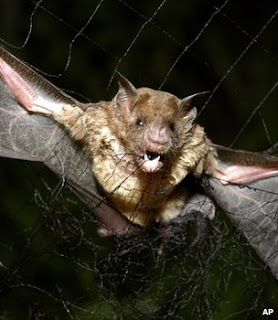 |
| Common vampire bats are a natural reservoir for the rabies virus |
Until now, it had been assumed that controlling bat numbers would, in turn, control the spread of the rabies virus.
Researchers say rabies is found in most bat populations, but vampire bats - which feed on mammals' blood - are responsible for most infections.
The findings have been published in the Proceedings of the Royal Society B.
"We found that rabies is there no matter what," said co-author Daniel Streicker, an ecologist at the University of Georgia, US.
"The size of the bat colony didn't predict the proportion of bats that were exposed to the virus.
"That's important because if there is no relationship between bat population density and rabies, then reducing the bat population won't reduce rabies transmission within bats."
Email ThisBlogThis!Share to TwitterShare to FacebookShare to Pinterest
Monday, June 11, 2012
Butterflies And Bats Aid In Research About Infectious Diseases
Human activity, habitat disruption may affect migration patterns and spread of infectious diseases
There’s a most unusual gym in ecologist Sonia Altizer’s lab at the University of Georgia in Athens. The athletes are monarch butterflies, and their workouts are carefully monitored to determine how parasites impact their flight performance.
With support from the National Science Foundation (NSF), Altizer and her team study how animal behavior, including long distance migration, affects the spread and evolution of infectious disease. In monarchs, the researchers study a protozoan parasite called Ophryocystis elektroscirrha, or “OE” for short.
In Altizer’s lab, the adult butterflies are tethered to a “flying treadmill” and the time and speed of each lap is recorded on a computer. They fly at between two and five miles per hour in this setting. Infected butterflies, on average, fly about 20 percent less well than healthy butterflies. “So, they actually fly shorter total distances, they’ve got slower flight speeds and they lose more weight per distance flown than healthy butterflies,” says Altizer.
There’s a most unusual gym in ecologist Sonia Altizer’s lab at the University of Georgia in Athens. The athletes are monarch butterflies, and their workouts are carefully monitored to determine how parasites impact their flight performance.
With support from the National Science Foundation (NSF), Altizer and her team study how animal behavior, including long distance migration, affects the spread and evolution of infectious disease. In monarchs, the researchers study a protozoan parasite called Ophryocystis elektroscirrha, or “OE” for short.
In Altizer’s lab, the adult butterflies are tethered to a “flying treadmill” and the time and speed of each lap is recorded on a computer. They fly at between two and five miles per hour in this setting. Infected butterflies, on average, fly about 20 percent less well than healthy butterflies. “So, they actually fly shorter total distances, they’ve got slower flight speeds and they lose more weight per distance flown than healthy butterflies,” says Altizer.
Email ThisBlogThis!Share to TwitterShare to FacebookShare to Pinterest
Subscribe to:
Posts (Atom)
Showing posts with label science. Show all posts
Showing posts with label science. Show all posts
Friday, April 11, 2014
Last Call - France HABE Prize
The France HABE Prize is awarded by the Department of Karst and the Cave Protection of the International Union of Speleology (UIS).
Its purpose is to promote the protection of karst and caves for generations to come. Their natural legacy are proven sources of increasingly rich information about the history of our planet and humanity, enabling people to act more thoughtfully, efficiently, and sustainably for the future of our environment.
Nominations must reach by, May 20 2014.
Click here for more information
Its purpose is to promote the protection of karst and caves for generations to come. Their natural legacy are proven sources of increasingly rich information about the history of our planet and humanity, enabling people to act more thoughtfully, efficiently, and sustainably for the future of our environment.
Nominations must reach by, May 20 2014.
Click here for more information
Thursday, June 6, 2013
Slicing Open Stalagmites to Reveal Climate Secrets
 |
| Stacy Carolin collects samples in a Borneo cave last fall. Photo by Syria Lejau |
A few years later, Carolin, a Ph.D. student at Georgia Tech, is breaking ground in the field of paleoclimatology, the study of ancient climates, using an unconventional but increasingly prevalent tool: speleothems, a catch-all term for cave formations that includes stalagmites (remember the mnemonic: those that "mite" reach the ceiling from the floor) and stalactites (those that hold "tite" to the ceiling).
Labels:
Borneo,
climate,
science,
Stacy Carolin,
stalagmites
Location:
Borneo
Tuesday, May 28, 2013
Smokies, Mammoth Cave part of MTSU science study
Ten college students from across the country are taking part in a Middle Tennessee State University environmental research project.
The event runs from through July 26 and is funded by the National Science Foundation.
The school says the students will search for ancient inactive seismic faults, investigate water and air quality and explore the ecology of rare cedar glade habitats. The intensified research project involves the disciplines of Earth science, chemistry and biology.
Field trips will take them to Mammoth Cave and the Great Smoky Mountains National Park.
The NSF grant of $368,000 also will enable MTSU to host similar studies in 2014 and 2015.
Source: Kentucky.com
The event runs from through July 26 and is funded by the National Science Foundation.
The school says the students will search for ancient inactive seismic faults, investigate water and air quality and explore the ecology of rare cedar glade habitats. The intensified research project involves the disciplines of Earth science, chemistry and biology.
Field trips will take them to Mammoth Cave and the Great Smoky Mountains National Park.
The NSF grant of $368,000 also will enable MTSU to host similar studies in 2014 and 2015.
Source: Kentucky.com
Labels:
Mammoth Cave,
science,
USA
Location:
Murfreesboro, Tennessee, Verenigde Staten
Thursday, May 23, 2013
New cave-dwelling whip scorpion species found
 |
| Rowlandius ubajara (above) is one of two new cave-dwelling whip scorpion species discovered in northeastern Brazil. |
Whip scorpions are not true scorpions, but rather part of a group of arachnids that don't have stings and are not poisonous. They possess a whip-like tail, but look more like ants.
Previously, scientists thought whip scorpions came predominantly from the Caribbean. The new species, Rowlandius ubajara and Rowlandius potiguara, are some of the first from South America.
Labels:
biology,
biospeleology,
Rowlandius ubajara,
science,
scorpion
Location:
Minas Gerais, Brazilië
Monday, April 15, 2013
21 st International Karstological School: Classical Karst: Hypogene Speleogenesis (Between theory and reality...)
Since 1993, International Karstological Schools have been organised, covering many aspects of karst research. The basic idea of the School has been to present the state of the art in selected topics and promote discussion between participants via set of lectures, poster sessions and related field trips to the area of Slovene Classical karst.
In the last decade, hypogene speleologenetic processes have attracted attention of speleological community. Many previously epigenic caves have been reinterpreted as hypogene. Some basic publications on the topic have triggered doubts and debates because similar cave patterns and wall rock features considered as hypogene can be formed also under other conditions. Therefore, the aim of the 21'st IKS is to present basic hydrogeological and chemical principles and processes of hypogene speleogenesis as well as geological conditions leading to it. Special attention will be paid to the geometry of cave passages and wall rock features which are often interpreted as hypogene, but could have as well formed otherwise, such as in meteoric flood-water conditions or by dissolution in contact with sediment.
In the last decade, hypogene speleologenetic processes have attracted attention of speleological community. Many previously epigenic caves have been reinterpreted as hypogene. Some basic publications on the topic have triggered doubts and debates because similar cave patterns and wall rock features considered as hypogene can be formed also under other conditions. Therefore, the aim of the 21'st IKS is to present basic hydrogeological and chemical principles and processes of hypogene speleogenesis as well as geological conditions leading to it. Special attention will be paid to the geometry of cave passages and wall rock features which are often interpreted as hypogene, but could have as well formed otherwise, such as in meteoric flood-water conditions or by dissolution in contact with sediment.
Info: http://iks.zrc-sazu.si/en/
Friday, December 28, 2012
Cave Dwelling Nettle Discovered in China
 |
| Flowers of a new species from the nettle family known only from caves, Pilea cavernicola, where it grows in very low light conditions. |
South West China, Myanmar and Northern Vietnam contain one of the oldest exposed outcrops of limestone in the world. Within this area are thousands of caves and gorges. It is only recently that botanists have sought to explore the caves for plants. This exploration is yielding many new species new to science, that are known only from these habitats.
The current study was published in the open access journal PhytoKeys.
Kew botanist and nettle expert Alex Monro says, "When my Chinese colleague Wei Yi-Gang from the Guangxi Institute of Botany first mentioned cave-dwelling plants to me, I thought that he was mis-translating a Chinese word into English. When we stepped into our first cave, Yangzi cave, I was spell-bound. It had an eerie moonscape look to it and all I could see were clumps of plants in the nettle family growing in very dark condition."
The plants do not grow in complete darkness but do grow in extremely low light levels, deep within the entrance caverns of the caves (sometimes, in as little as 0.04% full sunlight). The British and Chinese authors have been collecting plants from the Nettle family in this limestone landscape for several years and have just published a paper describing three new species, one from a cave and another two from deep gorges.
The cave-dwelling nettle species in question, was found growing in two caves in the Guangxi province of China. Of the species discovered in gorges, one is known from an unusual and striking rock mineral formation called petaloid travertine. Petaloid travertine is a form of limestone deposited by mineral springs that over time forms large petals of rock, in this case clinging to the vertical walls of a gorge.
These plants are members of a genus of Nettles known as Pilea, that is believed to have over 700 species Worldwide, up to one third of which may remain undescribed.
Journal Reference:
Alex Monro, Y.G. Wei, C.J. Chen. Three new species of Pilea (Urticaceae) from limestone karst in China. PhytoKeys, 2012; 19 (0): 51 DOI:10.3897/phytokeys.19.3968
Kew botanist and nettle expert Alex Monro says, "When my Chinese colleague Wei Yi-Gang from the Guangxi Institute of Botany first mentioned cave-dwelling plants to me, I thought that he was mis-translating a Chinese word into English. When we stepped into our first cave, Yangzi cave, I was spell-bound. It had an eerie moonscape look to it and all I could see were clumps of plants in the nettle family growing in very dark condition."
The plants do not grow in complete darkness but do grow in extremely low light levels, deep within the entrance caverns of the caves (sometimes, in as little as 0.04% full sunlight). The British and Chinese authors have been collecting plants from the Nettle family in this limestone landscape for several years and have just published a paper describing three new species, one from a cave and another two from deep gorges.
The cave-dwelling nettle species in question, was found growing in two caves in the Guangxi province of China. Of the species discovered in gorges, one is known from an unusual and striking rock mineral formation called petaloid travertine. Petaloid travertine is a form of limestone deposited by mineral springs that over time forms large petals of rock, in this case clinging to the vertical walls of a gorge.
These plants are members of a genus of Nettles known as Pilea, that is believed to have over 700 species Worldwide, up to one third of which may remain undescribed.
Journal Reference:
Alex Monro, Y.G. Wei, C.J. Chen. Three new species of Pilea (Urticaceae) from limestone karst in China. PhytoKeys, 2012; 19 (0): 51 DOI:10.3897/phytokeys.19.3968
Labels:
biospeleology,
China,
plants,
science,
Yangzi cave
Location:
Guangxi, Volksrepubliek China
Thursday, December 20, 2012
Researchers find link between bats and treatment of human diseases
 |
| Dr Chris Cowled hard at work |
Their paper, published today in the journal Science, provides an insight into the evolution of the bat’s flight, resistance to viruses, and relatively long life.
The Bat Pack, in collaboration with the Beijing Genome Institute, led a team that sequenced the genomes of two bat species - the Black Flying Fox, an Australian mega bat, and the David’s Myotis, a Chinese micro bat.
Once the genomes were sequenced, they compared them to the genomes of other mammals, including humans, to find where the similarities and differences lay.
Chris Cowled, post-doctoral fellow at AAHL says the research may eventually lead to strategies to treat, or even prevent disease in humans.
Tuesday, December 18, 2012
New paper on karstic flow conduits
A new paper is published in the current issue of "Speleogenesis and Evolution of karst aquifers":
Boudinet, P. 2012. A statistical model of karstic flow conduits.
Speleogenesis & Evolution of Karst Aquifers, 12: 9-16
A statistical model of karstic flow conduits, based on statistical physics of random walks, is developed. It allows us to compute the mean depth of flow conduits versus the distance from the inlet and versus the dip. It provides results that are in good qualitative agreement with previous results of other authors: the mean depth increases, slowly, with the distance, and it increases, not in a regular fashion, with the dip. The variability of the depth of the conduits, possibly leading to some conduits far from the water table, and the fact that well developed conduits are scarce or not, is linked to the probability of exploitation of the different fractures, the potentially permeable bedding planes, faults and joints in the karstifiable rock. On the basis of this result, we propose that interesting cavities - from the point of view of caving and cave diving - are found only in a small range of those exploitation probabilities. Finally, we emphasize the non-euclidean properties of flow conduits; especially, that many shortest pathways may exist and that a straight line is not usually the shortest pathway that actually develops between inlet and outlet.
To download the full paper, please, follow this link:
http://www.speleogenesis.info/journal/publication.php?id=11251
Boudinet, P. 2012. A statistical model of karstic flow conduits.
Speleogenesis & Evolution of Karst Aquifers, 12: 9-16
A statistical model of karstic flow conduits, based on statistical physics of random walks, is developed. It allows us to compute the mean depth of flow conduits versus the distance from the inlet and versus the dip. It provides results that are in good qualitative agreement with previous results of other authors: the mean depth increases, slowly, with the distance, and it increases, not in a regular fashion, with the dip. The variability of the depth of the conduits, possibly leading to some conduits far from the water table, and the fact that well developed conduits are scarce or not, is linked to the probability of exploitation of the different fractures, the potentially permeable bedding planes, faults and joints in the karstifiable rock. On the basis of this result, we propose that interesting cavities - from the point of view of caving and cave diving - are found only in a small range of those exploitation probabilities. Finally, we emphasize the non-euclidean properties of flow conduits; especially, that many shortest pathways may exist and that a straight line is not usually the shortest pathway that actually develops between inlet and outlet.
To download the full paper, please, follow this link:
http://www.speleogenesis.info/journal/publication.php?id=11251
Friday, December 14, 2012
Bad News for Bats: Deadly Fungus Persists in Caves
A study just published in Applied and Environmental Microbiology shows that the fungus can survive in soil for months, even years, after the bats have departed.
This is not good news for the bat population, says lead author Jeff Lorch, a research associate in the Department of Forest and Wildlife Ecology at the University of Wisconsin-Madison. "We have found that caves and mines, which remain cool year-round, can serve as reservoirs for the fungus, so bats entering previously infected sites may contract white-nose syndrome from that environment. This represents an important and adverse transmission route."
"This certainly presents additional challenges," adds David Blehert, a microbiologist at the U.S. Geological Survey National Wildlife Health Center in Madison, who also led the study. "It's important that we have completed this foundational work that further implicates the environment in the ecology of this infectious disease. We can now collectively move forward to address this problem."
This is not good news for the bat population, says lead author Jeff Lorch, a research associate in the Department of Forest and Wildlife Ecology at the University of Wisconsin-Madison. "We have found that caves and mines, which remain cool year-round, can serve as reservoirs for the fungus, so bats entering previously infected sites may contract white-nose syndrome from that environment. This represents an important and adverse transmission route."
"This certainly presents additional challenges," adds David Blehert, a microbiologist at the U.S. Geological Survey National Wildlife Health Center in Madison, who also led the study. "It's important that we have completed this foundational work that further implicates the environment in the ecology of this infectious disease. We can now collectively move forward to address this problem."
Thursday, December 13, 2012
Blind cave fish inspires sensing system for autonomous underwater vehicles
Ever wonder how fish can find their way around so easily in murky water? Well, most of them use something called their lateral line - a row of hair cells down either side of their body that detect changes in water pressure caused by movement, or by water flowing around objects. Now, scientists from Singapore’s Nanyang Technological University and MIT have copied the lateral lines of the blind cave fish, in a man-made system designed to allow autonomous underwater vehicles (AUVs) to navigate more accurately and efficiently.
Ordinarily, AUVs use cameras, sonar, or an underwater acoustic positioning system. Cameras aren’t much use in murky water, however - and a lot of the world’s water bodies are murky. Sonar and acoustics are better in such situations, but the hardware can be expensive, and taxing on the AUV’s batteries.
Ordinarily, AUVs use cameras, sonar, or an underwater acoustic positioning system. Cameras aren’t much use in murky water, however - and a lot of the world’s water bodies are murky. Sonar and acoustics are better in such situations, but the hardware can be expensive, and taxing on the AUV’s batteries.
Sunday, December 9, 2012
Research on stricken bats may help AIDS fight
The remote possibility that an AIDS treatment can arise from the study of white-nose is about the only positive development since the bat disease was first discovered in a cave near Albany, N.Y., in 2008.
Between 5 million and 7 million bats of various species have died from the disease since that year. In Pennsylvania alone, 95 percent of little brown bats have died.
Bats have an ugly reputation as villains in books and movies, but in reality are as important as birds and bees. They pollinate plants, and a single reproductive female consumes her weight in bugs each night. A colony of 150 brown bats can eat enough adult cucumber beetles to prevent the laying of eggs that results in 33 million rootworm larvae in summer, according to a study cited by Bat Conservation International.
Between 5 million and 7 million bats of various species have died from the disease since that year. In Pennsylvania alone, 95 percent of little brown bats have died.
Bats have an ugly reputation as villains in books and movies, but in reality are as important as birds and bees. They pollinate plants, and a single reproductive female consumes her weight in bugs each night. A colony of 150 brown bats can eat enough adult cucumber beetles to prevent the laying of eggs that results in 33 million rootworm larvae in summer, according to a study cited by Bat Conservation International.
Friday, November 30, 2012
New Eyeless, Scaleless Cave Fish Discovered in Vietnam
A cave-dwelling fish with no eyes and no scales has been discovered on a tiny island in Vietnam's scenic Ha Long Bay, according to conservation group Fauna & Flora International.
The newly described fish, a type of loach, has been named Draconectes narinosus, which derives from the Greek words for dragon "drakon" and swimmer "nectes," as well as the Latin word "narinosus," which means "who has large nostrils."
Its lack of eyes and scales are actually common adaptations for animals that have evolved in the darkness of deep limestone caverns. Like other cave fish, D. narinosus is limited to a life in freshwater, which means it is likely confined to a system of subterranean caves on Van Gio Island, unable to swim out into the surrounding sea.
The newly described fish, a type of loach, has been named Draconectes narinosus, which derives from the Greek words for dragon "drakon" and swimmer "nectes," as well as the Latin word "narinosus," which means "who has large nostrils."
Its lack of eyes and scales are actually common adaptations for animals that have evolved in the darkness of deep limestone caverns. Like other cave fish, D. narinosus is limited to a life in freshwater, which means it is likely confined to a system of subterranean caves on Van Gio Island, unable to swim out into the surrounding sea.
Labels:
biospeleology,
fish,
science,
Vietnam
Location:
Hòn Gió, Vietnam
Wednesday, November 28, 2012
Cave Structure Tells Tale of 13,000 Winters
Scientists have found a stalagmite in an Oregon cave that tells the story of thousands of winters in the Pacific Northwest.
"Most other ways of estimating past climate, like tree-ring data, only tell us about summers, when plants are growing," Oxford University researcher Vasile Ersek said in a statement. But understanding ancient winters is also important for regions like western North America, where chilly conditions are critical for determining water resources.
For their study, Ersek and his colleagues examined a cave formation called a stalagmite that started forming 13,000 years ago in a cavern in what is now Oregon Caves National Monument. During the region's damp winters, water from the ground seeped through the cave's ceiling and trickled onto the floor, with the drips slowly forming the stalagmite over time.
"Most other ways of estimating past climate, like tree-ring data, only tell us about summers, when plants are growing," Oxford University researcher Vasile Ersek said in a statement. But understanding ancient winters is also important for regions like western North America, where chilly conditions are critical for determining water resources.
For their study, Ersek and his colleagues examined a cave formation called a stalagmite that started forming 13,000 years ago in a cavern in what is now Oregon Caves National Monument. During the region's damp winters, water from the ground seeped through the cave's ceiling and trickled onto the floor, with the drips slowly forming the stalagmite over time.
Labels:
climate,
Oregon Caves,
science,
USA
Location:
Oregon, Verenigde Staten
Skeletons in cave reveal Mediterranean secrets
 |
| Location of Upper Palaeolithic and Mesolithic sites on the Ègadi Islands and in NW Sicily. |
Skeletal remains in an island cave in Favignana, Italy, reveal that modern humans first settled in Sicily around the time of the last ice age and despite living on Mediterranean islands, ate little seafood. The research is published November 28 in the open access journal PLOS ONE by Marcello Mannino and colleagues from the Max Planck Institute for Evolutionary Anthropology, Germany.
Genetic analysis of the bones discovered in caves on the Egadi islands provides some of the first mitochondrial DNA data available for early humans from the Mediterranean region, a crucial piece of evidence in ancestry analysis. This analysis reveals the time when modern humans reached these islands. Mannino says, "The definitive peopling of Sicily by modern humans only occurred at the peak of the last ice age, around 19,000 -26,500 years ago, when sea levels were low enough to expose a land bridge between the island and the Italian peninsula".
The authors also analyzed the chemical composition of the human remains and found that these early settlers retained their hunter-gatherer lifestyles, relying on terrestrial animals rather than marine sources for meat. According to the study, despite living on islands during a time when sea level rise was rapid enough to change within a single human lifetime, these early settlers appear to have made little use of the marine resources available to them. The authors conclude, "These findings have crucial implications for studies of the role of seafood in the diet of Mediterranean hunter-gatherers."
Scientific article:
Mannino MA, Catalano G, Talamo S, Mannino G, Di Salvo R, et al. (2012) Origin and Diet of the Prehistoric Hunter-Gatherers on the Mediterranean Island of Favignana (E`gadi Islands, Sicily). PLoS ONE 7(11): e49802. doi:10.1371/journal.pone.0049802
Friday, November 9, 2012
Thermal scans of bat faces warn of infected individuals before they show symptoms.
Bats are a major reservoir for the rabies virus, according to the Centers for Disease Control and Prevention (CDC) in Atlanta.
Rabies, typically transmitted in saliva, targets the brain and is almost always fatal in animals and people if left untreated. No current tests detect rabies in live animals—only brain tissue analysis is accurate.
Searching for a way to detect the virus in bats before the animals died, rabies specialist James Ellison and his colleagues at the CDC turned to a captive colony of big brown bats (Eptesicus fuscus). Previous studies had found temperature increases in the noses of rabid raccoons, so the team expected to see similar results with bats.
Rabies, typically transmitted in saliva, targets the brain and is almost always fatal in animals and people if left untreated. No current tests detect rabies in live animals—only brain tissue analysis is accurate.
Searching for a way to detect the virus in bats before the animals died, rabies specialist James Ellison and his colleagues at the CDC turned to a captive colony of big brown bats (Eptesicus fuscus). Previous studies had found temperature increases in the noses of rabid raccoons, so the team expected to see similar results with bats.
Monday, October 1, 2012
Three New Arthropod Species Have Been Found in the Maestrazgo Caves in Teruel
 |
| Pygmarrhopalites maestrazgoensis |
The Maestrazgo caves in Teruel are located in a region of the Iberian Range where fauna has not been the subject of much study. It is a very isolated region since its average altitude is between 1,550 m and 2,000 m asl and its climate can be described as "almost extreme" experiencing temperatures of between -40°C and -25°C. Inside the caves, however, the temperatures remain constant at between 5°C and 11°C.
Labels:
Arthropod,
biospeleology,
Maestrazgo caves,
science,
Spain
Location:
Teruel, Spanje
Wednesday, August 22, 2012
Neandertal's Right-handedness Hints at Language Capacity
There are precious few Neandertal skeletons available to science. One of the more complete was discovered in 1957 in France, roughly 900 yards away from the famous Lascaux Cave. That skeleton was dubbed “Regourdou.” Then, about two decades ago, researchers examined Regourdou’s arm bones and theorized that he had been right-handed.
Labels:
archeology,
France,
Lascaux,
Neanderthals,
science
Location:
Lascaux, Frankrijk
Friday, August 3, 2012
Neanderthal's sister species once roamed Africa
Early humans in Africa procreated with a mystery species of human that may have been related toNeanderthals that later inhabited Europe, according to latest genetic studies.
While no fossilized bones have been found from these enigmatic people, they did leave their mark in present-day Africans: snippets of foreign DNA.
Scientists insist that there's only one way that genetic material could have made it into modern human populations.
"Geneticists like euphemisms, but we're talking about sex," the Washington Post quoted Joshua Akey of the University of Washington in Seattle, whose lab identified the mystery DNA in three groups of modern Africans, as saying.
According to Akey, these genetic leftovers do not resemble DNA from any modern-day humans. The foreign DNA also does not resemble Neanderthal DNA, which shows up in the DNA of some modern-day Europeans.
That means the newly identified DNA came from an unknown group.
"We're calling this a Neanderthal sibling species in Africa," Akey said.
He further said that the interbreeding probably occurred 20,000 to 50,000 years ago, long after some modern humans had walked out of Africa to colonize Asia and Europe, and around the same time Neanderthals were declining in Europe.
The find offers more evidence that for thousands of years, modern-looking humans shared the Earth with evolutionary cousins that later became extinct.
And whenever the groups met, whether in Africa or Europe, they bred.
In fact, hominid hanky-panky seems to have occurred wherever humans met others who looked kind of like them - a controversial idea until recently.
The research was recently published in the journal Cell:
Evolutionary History and Adaptation from High-Coverage Whole-Genome Sequences of Diverse African Hunter-Gatherers, Cell, Volume 150, Issue 3, 457-469, 26 July 2012
While no fossilized bones have been found from these enigmatic people, they did leave their mark in present-day Africans: snippets of foreign DNA.
Scientists insist that there's only one way that genetic material could have made it into modern human populations.
"Geneticists like euphemisms, but we're talking about sex," the Washington Post quoted Joshua Akey of the University of Washington in Seattle, whose lab identified the mystery DNA in three groups of modern Africans, as saying.
According to Akey, these genetic leftovers do not resemble DNA from any modern-day humans. The foreign DNA also does not resemble Neanderthal DNA, which shows up in the DNA of some modern-day Europeans.
That means the newly identified DNA came from an unknown group.
"We're calling this a Neanderthal sibling species in Africa," Akey said.
He further said that the interbreeding probably occurred 20,000 to 50,000 years ago, long after some modern humans had walked out of Africa to colonize Asia and Europe, and around the same time Neanderthals were declining in Europe.
The find offers more evidence that for thousands of years, modern-looking humans shared the Earth with evolutionary cousins that later became extinct.
And whenever the groups met, whether in Africa or Europe, they bred.
In fact, hominid hanky-panky seems to have occurred wherever humans met others who looked kind of like them - a controversial idea until recently.
The research was recently published in the journal Cell:
Evolutionary History and Adaptation from High-Coverage Whole-Genome Sequences of Diverse African Hunter-Gatherers, Cell, Volume 150, Issue 3, 457-469, 26 July 2012
Wednesday, June 13, 2012
Culling bats does not halt rabies, says report
 |
| Common vampire bats are a natural reservoir for the rabies virus |
Until now, it had been assumed that controlling bat numbers would, in turn, control the spread of the rabies virus.
Researchers say rabies is found in most bat populations, but vampire bats - which feed on mammals' blood - are responsible for most infections.
The findings have been published in the Proceedings of the Royal Society B.
"We found that rabies is there no matter what," said co-author Daniel Streicker, an ecologist at the University of Georgia, US.
"The size of the bat colony didn't predict the proportion of bats that were exposed to the virus.
"That's important because if there is no relationship between bat population density and rabies, then reducing the bat population won't reduce rabies transmission within bats."
Monday, June 11, 2012
Butterflies And Bats Aid In Research About Infectious Diseases
Human activity, habitat disruption may affect migration patterns and spread of infectious diseases
There’s a most unusual gym in ecologist Sonia Altizer’s lab at the University of Georgia in Athens. The athletes are monarch butterflies, and their workouts are carefully monitored to determine how parasites impact their flight performance.
With support from the National Science Foundation (NSF), Altizer and her team study how animal behavior, including long distance migration, affects the spread and evolution of infectious disease. In monarchs, the researchers study a protozoan parasite called Ophryocystis elektroscirrha, or “OE” for short.
In Altizer’s lab, the adult butterflies are tethered to a “flying treadmill” and the time and speed of each lap is recorded on a computer. They fly at between two and five miles per hour in this setting. Infected butterflies, on average, fly about 20 percent less well than healthy butterflies. “So, they actually fly shorter total distances, they’ve got slower flight speeds and they lose more weight per distance flown than healthy butterflies,” says Altizer.
There’s a most unusual gym in ecologist Sonia Altizer’s lab at the University of Georgia in Athens. The athletes are monarch butterflies, and their workouts are carefully monitored to determine how parasites impact their flight performance.
With support from the National Science Foundation (NSF), Altizer and her team study how animal behavior, including long distance migration, affects the spread and evolution of infectious disease. In monarchs, the researchers study a protozoan parasite called Ophryocystis elektroscirrha, or “OE” for short.
In Altizer’s lab, the adult butterflies are tethered to a “flying treadmill” and the time and speed of each lap is recorded on a computer. They fly at between two and five miles per hour in this setting. Infected butterflies, on average, fly about 20 percent less well than healthy butterflies. “So, they actually fly shorter total distances, they’ve got slower flight speeds and they lose more weight per distance flown than healthy butterflies,” says Altizer.
Subscribe to:
Posts (Atom)

